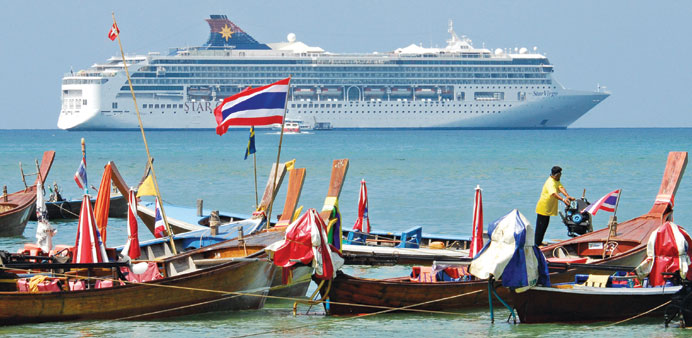Traditional Thai longtail boats wait for customers as a cruise ship is anchored off the beach in Patong on Phuket island, southern Thailand (file). The number of visitors from the Middle East grew by 31% to 55,521, with arrivals from the Kuwait and the UAE showing the greatest leaps at plus 92% and plus 115%, respectively.
By Arno Maierbrugger/Gulf Times Correspondent /Bangkok
After a challenging year 2014 during which foreign tourist arrivals to Thailand slumped by 6.7% to 24,7mn – way below the forecast of 28mn – January 2015 has seen an upwards tendency due to a major comeback by almost all important source markets, including the top performers Malaysia, South Korea, Japan, the US, Germany, the UK and India, as well as the Middle East.
The Thai Ministry of Tourism and Sports on March 18 announced that Thailand’s visitor arrivals climbed to a monthly record total of 2,654,634 during the high season in January 2015, up by 16.3% compared to January 2014.
Thawatchai Arunyik, governor of the Tourism Authority of Thailand (TAT), said that he hopes the turnaround in tourism arrival will be sustainable.
“We faced a very difficult and challenging 2014, but the tourism numbers turned around at the end of 2014, which was followed by an excellent start into 2015. We hope to maintain this trend through the year,” Arunyik said.
Looking at the numbers, arrivals from all source regions grew well except Europe, Russia and Oceania. The largest jump in arrivals was from East Asia at 43.25% to more than 1. 54mn. This number includes China as the now largest single tourism source country for Thailand with January arrivals of 560,399, or plus 57%.
The number of visitors from the Middle East grew by 31% to 55,521, with arrivals from the Kuwait and the UAE showing the greatest leaps at plus 92% and plus 115%, respectively. Even arrivals from Saudi Arabia were up by more than 10% to over 1,000 travellers, which is interesting.
The ministry does not reveal visitor numbers for Qatar in particular.
Governor Arunyik attributed the positive trend to the TAT’s “tourism revival strategies” that had produced “excellent results”. The strategies include the new slogan “Discover Thainess” and are highlighting the current state of martial law in the junta-ruled country as being “good for tourists’ safety.”
On the downside, arrivals from Europe and Russia declined drastically. Europe’s current economic crisis and, particularly, the weak euro resulted in a slump of more than 14% in arrivals from Europe. The exchange rate has fallen from 45 baht per euro to around 35 baht over the past twelve months, reducing the purchasing power of tourists from Eurozone countries in Thailand by more than a quarter.
Arrival numbers from Russia in January declined by 46% to 269,479 after a minus of more than 8% throughout 2014. The value of the rouble relative to the baht crashed from parity in January 2014 to slightly above 0.50 in mid-March, effectively doubling all prices for Russians in Thailand. As a consequence, property agents observe high numbers of payment defaults of Russians who have bought off-plan property in Thailand before their country fell into its current economic crisis, as they are unable to meet their instalments that are now – in rouble terms – up to twice as high as before.
Despite these problems and helped by surging arrivals from other regions, the TAT has reiterated its target of 28mn international visitors for 2015, which are expected to generate an estimated $41.5bn in tourism receipts.



